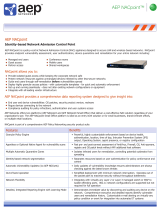
Security Issues
The security issues facing Enterprise
networks have evolved over the
years, with the focus moving from
mitigating outward attacks, to
reducing internal breaches and the
inltration of malicious software. This
internal defense requires signicant
involvement with individual devices
on a network, which creates greater
overhead on network administrators.
Allied Telesis lowers this overhead
and provides an effective solution
to internal network security, by
integrating advanced switching
technology as a part of Network
Access Control (NAC).
The evolution of network defenses
For many years, the focus in Enterprise
network security was on defending
against external threats. Firewalls were
installed to protect the LAN from the
hackers, worms, spammers and other
security dangers of the Internet.
However, with the growth in mobile
computing and the proliferation of
Ethernet-capable devices, LAN-based
attacks now outnumber external threats
as the main security issues facing network
administrators. Thus, attention has turned
towards the ‘enemy within’ - the security
dangers lurking within the local LAN.
Malicious software, known as malware,
makes its way onto a network via
employees, contractors and visitors.
Personal laptops, wireless gadgets,
and ever-popular USB ash drives all
provide excellent vectors through which
malware can enter the workplace. Even
careful employees can unwittingly bring
in malware, by using their equipment
outside of the network. Visitors and
contractors may be careless carriers of
malware or, even worse, may be planning
a malicious attack to steal data or cause
disruption.
Defense against the enemy within
To effectively defend the network against
internal threats, network administrators
need secure LAN switches that provide
protection against common attacks. They
also need to implement policies that
ensure that each device connecting to
a network is as secure as possible. This
combination of secure LAN switches and
anti-malware policy can be very effective.
Allied Telesis switches have always
provided a comprehensive range of
defenses to combat internal attacks.
These attacks range from data stealing
attacks, such as Address Resolution
Protocol (ARP) spoong, to Denial of
Service (DoS) attacks such as Tear Drop
or Ping of Death. Correct deployment
of these defenses can create a network
that is impermeable to most of the harm
these attacks cause.
Additionally, network administrators
can institute a policy whereby network
users are required to install and maintain
anti-malware scanners, and to install
security patches as they are released by
Operating System vendors. However,
this has required network administrators
to spend time ensuring that users are
adhering to policies, and has even
generated counter-productive tension
between network administrators and
users.
More detailed information on how Allied Telesis secure LAN switches
defend against the various types of LAN threats can be found on our
website: http://www.alliedtelesis.com/solutions/netsecurity
| Network Access Control (NAC) Solution
alliedtelesis.com
2











